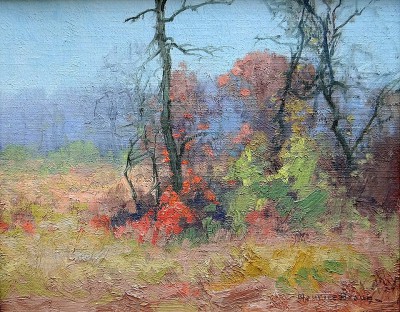
Maurice Braun stands as a significant figure in the history of American art, particularly celebrated for his contributions to the Californian Impressionist movement. Born in Hungary but intrinsically linked to the landscapes of Southern California, Braun's life and work offer a fascinating study of artistic development, transatlantic influences, and the establishment of regional art scenes. His canvases, bathed in the distinctive light of the American West, capture the essence of a specific time and place, securing his legacy as a master interpreter of the Californian terrain.
Early Life and Artistic Awakening
Maurice Braun was born on October 1, 1877, in Nagy-Bittse, Hungary, which is now part of the Czech Republic. His journey as an American artist began early, as his family emigrated to the United States when he was just four years old, settling in New York City. This bustling metropolis would become the backdrop for his formative years and initial artistic training. Even from a young age, Braun exhibited a strong inclination towards art. Reports suggest he began drawing around the age of three, a precocious start to a lifelong passion. As a youth, he honed his observational skills and understanding of masterworks by spending time sketching the collections at the Metropolitan Museum of Art, a common practice for aspiring artists seeking self-directed study.
This early immersion in the art world laid the groundwork for his formal education. New York City, at the turn of the 20th century, was a vibrant center for artistic training, offering opportunities to study under established painters and engage with diverse artistic currents. Braun's dedication was evident, and he soon sought structured instruction to refine his burgeoning talent.
Formal Education in New York
Between 1897 and 1900, Maurice Braun undertook rigorous training at the prestigious National Academy of Design in New York. This institution was a bastion of traditional art education in America, emphasizing strong drawing skills, anatomical accuracy, and compositional principles rooted in European academic practices. During his time at the Academy, Braun studied under several notable instructors who imparted the tenets of the French academic tradition.
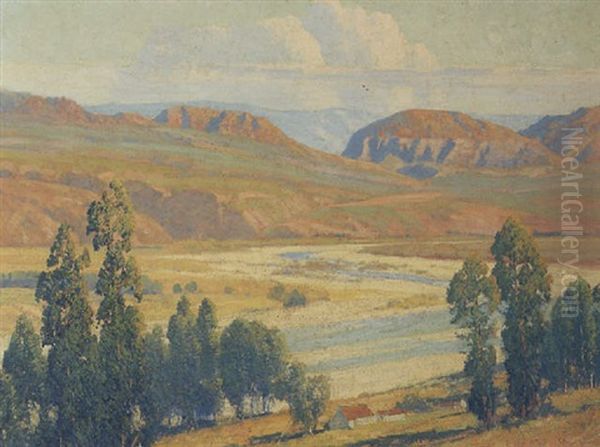
His teachers included Francis C. Jones (1857-1932), known for his genre scenes and murals; George Willoughby Maynard (1843-1923), another respected figure painter and muralist; and Edgar Melville Ward (1839-1915), recognized for his genre paintings often depicting craftsmen and historical settings. Studying under these artists provided Braun with a solid technical foundation, mastering draftsmanship and the principles of pictorial construction that would underpin his later, more impressionistic explorations. His proficiency was recognized early on, culminating in winning the Academy's Hallgarten Prize in 1900, an award given for the best oil painting by an American artist under the age of thirty-five.
The Influence of William Merritt Chase
Following his studies at the National Academy of Design, Braun sought further refinement under one of the most influential American artists and educators of the era: William Merritt Chase (1849-1916). In 1901, Braun enrolled for a year at Chase's eponymous school, the Chase School of Art (which later became the New York School of Art). Chase was a charismatic figure and a pivotal proponent of Impressionism in America, renowned for his bravura brushwork, keen sense of light and color, and advocacy for plein air (outdoor) painting.
Studying with Chase marked a significant turning point for Braun. While his NAD training provided academic rigor, Chase exposed him to a more modern sensibility. Chase encouraged direct observation,Alla Prima (wet-on-wet) techniques, and a brighter palette, characteristic of Impressionism. He instilled in his students the importance of capturing fleeting moments and the effects of light. This experience undoubtedly broadened Braun's artistic horizons, introducing him to the stylistic freedoms and painterly approaches that would become central to his mature work, particularly his landscape painting. The emphasis on capturing light directly from nature resonated deeply with Braun.
European Sojourn
Like many aspiring American artists of his generation, Maurice Braun recognized the value of experiencing European art firsthand. In 1902, following his studies with Chase, he embarked on a year-long trip abroad. While details of his specific activities are somewhat sparse, it is known that his travels focused primarily on Central Europe, including Austria, Germany, and his native Hungary. This journey provided him with the opportunity to study Old Masters and contemporary European art movements directly.
While he didn't follow the typical path of studying in Paris, the exposure to European artistic traditions and landscapes would have inevitably broadened his perspective. Seeing the works of European landscape painters and potentially encountering various strands of Post-Impressionism or Symbolism could have subtly informed his developing style. This period of travel and study concluded his formal artistic education, equipping him with a diverse range of influences and techniques as he prepared to launch his professional career back in the United States.
Return to New York and Transition
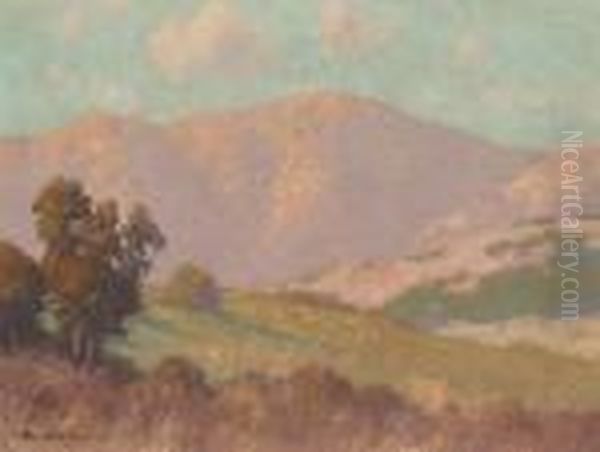
Upon returning to New York City around 1903, Maurice Braun initially established himself as a portrait and figure painter. Leveraging his strong academic training, he achieved a degree of success in this field. Portraiture was a reliable source of income for many artists, and his skills honed at the NAD and under Chase made him adept at capturing likenesses and character. New York provided ample opportunities for commissions, and he became a recognized figure in the city's art circles during these early years.
However, Braun's artistic interests began to shift. The allure of landscape painting, likely kindled during his time with William Merritt Chase and perhaps reinforced by his European travels, grew stronger. The constraints of portraiture may have felt limiting compared to the expressive possibilities offered by nature. He increasingly turned his attention towards capturing the world outdoors, exploring the interplay of light, color, and atmosphere. This gradual transition marked a pivotal moment in his career, setting the stage for the defining move that would shape his artistic identity.
The Move West: Embracing California
In a decisive shift away from the established New York art scene, Maurice Braun relocated to San Diego, California, around 1909 or 1910. This move was transformative for his art and life. Southern California, with its unique topography, intense sunlight, and burgeoning cultural identity, offered a fresh canvas and a profound source of inspiration. The region's dramatic landscapes – rolling hills, arid deserts, coastal bluffs, and distant mountains – were markedly different from the East Coast environments he had known.
Braun was captivated by the quality of light and the natural beauty of the region. He quickly became an integral part of the developing San Diego art community. The move allowed him to fully dedicate himself to landscape painting, the genre for which he would become most renowned. He established a studio and immersed himself in depicting the local scenery, rapidly gaining recognition as a leading interpreter of the Southern Californian landscape. His arrival coincided with a growing interest in regional art, and he played a crucial role in shaping the artistic identity of the area.
Founding Institutions: Educator and Organizer
Maurice Braun was not only a dedicated painter but also a significant force in organizing and promoting the arts in his adopted home. Recognizing the need for structured art education and exhibition opportunities in San Diego, he became a key community leader. In 1912, he founded the San Diego Academy of Art, serving as its director for many years. This institution provided crucial training for aspiring local artists, fostering a new generation grounded in solid technique while encouraging engagement with modern styles like Impressionism.
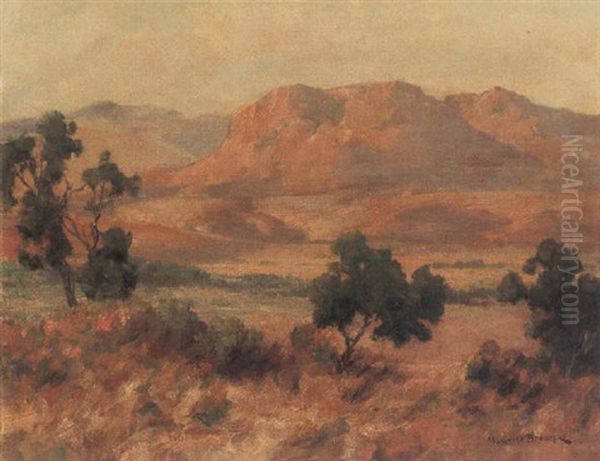
Beyond the Academy, Braun was deeply involved in other local arts organizations. He was a founding member of the La Jolla Art Association, established in 1918, which played a vital role in the cultural life of the seaside community, providing a venue for artists to exhibit and sell their work. His involvement extended to the early efforts related to establishing a major art gallery in the city, contributing to the foundation that would eventually lead to institutions like the San Diego Museum of Art. Braun actively promoted San Diego as an ideal location for artists, believing its natural beauty and climate were conducive to creative work. His efforts significantly elevated the region's cultural profile.
Artistic Style: Capturing the Californian Light
Maurice Braun's mature style is firmly rooted in Impressionism, specifically the regional variant known as Californian Impressionism. His primary focus was capturing the unique effects of light and atmosphere in the Southern California landscape. He possessed a remarkable sensitivity to the nuances of sunlight, shadow, and color as they played across the hills, canyons, and coastlines. His work is characterized by a harmonious balance between representational accuracy and impressionistic interpretation.
Braun often employed a vibrant but controlled palette, using color to convey the warmth and intensity of the Californian sun without resorting to exaggeration. His brushwork, while painterly, often retained a sense of structure and form, reflecting his academic background. Some sources note a characteristic use of clear, dense, and sometimes flowing or serpentine lines, particularly in his drawings and watercolors, which complemented his oil painting technique. He excelled at depicting the hazy, atmospheric quality often present in the region, imbuing his landscapes with a sense of tranquility and poetic beauty. His subjects ranged from the rolling hills around San Diego and the arid beauty of the nearby deserts to the majestic peaks of the High Sierra.
Theosophy and Spiritual Dimensions
An intriguing aspect of Maurice Braun's life and potentially his art is his connection with the Theosophical Society, particularly the community established at Point Loma in San Diego under Katherine Tingley. Braun was associated with the society, though the extent of his formal membership or deep involvement remains somewhat debated. He maintained a studio and gallery space for a time in the Isis Theater building, part of the Point Loma homestead. Theosophy, with its blend of Eastern mysticism, philosophy, and esoteric thought, emphasized harmony between humanity, nature, and the cosmos.
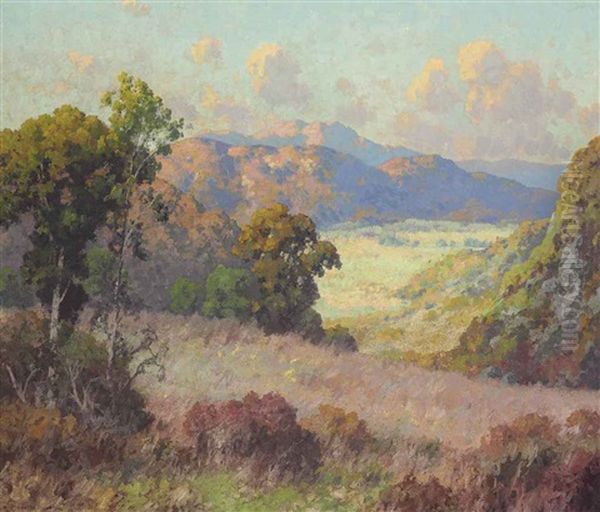
Some art historians have interpreted Braun's work through a Theosophical lens, suggesting that the serene, almost mystical quality found in many of his landscapes reflects these spiritual beliefs. They point to the emphasis on nature's inherent beauty and the sense of underlying unity as potential indicators of this influence. However, it's important to note that Braun's family later contested interpretations that heavily emphasized mysticism or religious belief as the primary driver of his art, stating he would have likely rejected such labels. Regardless of the precise nature of his beliefs, the Point Loma connection places him within a fascinating cultural milieu that undoubtedly influenced the intellectual and artistic climate of early 20th-century San Diego.
Representative Works and Recognition
Throughout his career, Maurice Braun produced a significant body of work across various media, including oil, watercolor, and drawing. While many of his most famous works are his oil landscapes of Southern California, specific titles mentioned in sources highlight his versatility. Works like Mission Valley (oil) exemplify his classic Californian landscape style, capturing the local topography and light. Other mentioned pieces, such as Letter to Charlotte, no. 2, Sketches of Animals (watercolor) and Paradise Park (pencil and ink), suggest a broader range of subjects and media, including intimate sketches and potentially illustrative work.
Braun's talent garnered significant recognition during his lifetime. Beyond the early Hallgarten Prize, a major accolade was the Gold Medal he received at the prestigious Panama-California Exposition held in San Diego's Balboa Park in 1915. He won another gold medal at the subsequent Panama-California International Exposition in 1916. These awards cemented his reputation on a national level. His paintings were exhibited widely and acquired by important institutions. Today, his works are held in the collections of numerous museums, including the Los Angeles County Museum of Art (LACMA), the San Diego Museum of Art, the Irvine Museum Collection at the University of California, Irvine, the Laguna Art Museum, and the Museum of Fine Arts, Houston (MFAH), among others.
Braun in Context: Contemporaries and Influences
To fully appreciate Maurice Braun's contribution, it's helpful to place him within the broader context of American and Californian art. His training connects him directly to key figures: his academic teachers Francis C. Jones, George W. Maynard, and Edgar M. Ward, and the influential Impressionist William Merritt Chase. Chase himself was part of the movement that brought Impressionism to America, alongside artists like Childe Hassam, John Henry Twachtman, and J. Alden Weir, whose works Braun would certainly have known.
In California, Braun became a leading figure among a remarkable group of artists who adapted Impressionist principles to the unique conditions of the West Coast. His contemporaries in the Californian Impressionist school included notable painters such as Guy Rose (1867-1925), who brought direct experience from Giverny; William Wendt (1865-1946), often called the "dean" of Southern California landscape painters for his powerful, structured depictions; Edgar Payne (1883-1947), famed for his dramatic Sierra Nevada landscapes and coastal scenes; Granville Redmond (1871-1935), known for his vibrant depictions of poppy fields, often with a Tonalist sensibility; Alson S. Clark (1876-1949), who also worked in Panama and Europe; Franz Bischoff (1864-1929), initially a porcelain painter who became celebrated for his bold landscapes; and Marion Kavanagh Wachtel (1876-1954), a master watercolorist often working in a delicate, Tonalist-Impressionist style. Braun's work shares affinities with these artists yet retains its distinct, lyrical quality. He also would have been aware of the foundational French Impressionists like Claude Monet and Camille Pissarro.
Later Years and Legacy
Maurice Braun remained dedicated to his art throughout his life. While best known for his landscapes, in his later years, he also devoted more attention to painting floral arrangements and still lifes. These works continued to showcase his sensitivity to color, light, and composition, albeit on a more intimate scale. He continued to paint, teach, and participate in the San Diego art community until his health declined.
Maurice Braun passed away on November 7, 1941, in San Diego, California. He left behind a substantial body of work that continues to be admired for its technical skill, aesthetic beauty, and evocative portrayal of the Southern California landscape during a period of significant growth and transformation. His role as an educator and organizer was equally important, helping to establish San Diego as a recognized center for the arts. His paintings remain highly sought after by collectors and are essential components of exhibitions focusing on American Impressionism and the art of California.
Conclusion
Maurice Braun's journey from a young immigrant in New York City to a celebrated leader of the Californian Impressionist movement is a testament to his talent, dedication, and adaptability. Grounded in solid academic training yet inspired by the light-filled canvases of Impressionism, he forged a distinctive style perfectly suited to capturing the unique beauty of his adopted home. His landscapes of Southern California are more than mere depictions; they are lyrical interpretations imbued with a sense of harmony and tranquility. Through his paintings, his teaching, and his community involvement, Maurice Braun made an enduring contribution to American art, leaving a legacy that continues to resonate with viewers today, inviting them to see the Californian landscape through his sensitive and masterful eyes.